Eye For Film >> Movies >> All The Beauty And The Bloodshed (2022) Film Review
All The Beauty And The Bloodshed
Reviewed by: Jennie Kermode

There’s a scene about two thirds of the way through Laura Poitras’ festival hit documentary in which it emerges that members of Prescription Addiction Intervention Now (PAIN), the organisation with which photographer Nan Goldin famously campaigned against the Sackler family, have been being followed. This is easy to believe – the testimony given makes sense, and it sounds like a rather clumsy job. It is introduced, however, with a young, blond white woman talking about how she noticed it when walking home alone one night, and how afraid it made her. The camera zooms in close on her face, on her wide eyes and trembling lower lip. This is the stuff of true crime TV. It assails the viewer with a host of well-established tropes guaranteed to provoke concern, none of which have anything to do with the subject at hand. It’s one of the less subtle examples of a sleight of hand at work throughout the film.
A number of interwoven themes are covered here. There is the history of the anti-Sackler campaign. There is Goldin’s personal history. There is a potted history of her sister’s life, with attendant family background and reflections on how her sister’s suicide affected her. There is also reflection on the artistic scene which she became a part of in New York, with particular focus on the life she lived before coming to prominence: an aetiology of creative growth against a background of romanticised poverty. These themes alternately fade and recede over the film’s substantial running time, sometimes shining light upon one another, sometimes dependent on songs for any meaning at all. The film is most interesting as a character study, but is not always flattering. One thing which it does well is to illustrate the chaos of living and the damage done by echoing trauma.

Several times over the course of the film, Goldin describes the Sackler family as ‘pure evil’. This is a sentiment which will be echoed by many in a country where over a thousand people a week die from overdosing on opioid-related drugs, yet if one looks at England and Wales, which together have around a fifth of the population, one sees a rate of just 47 people per week. The drug which the Sacklers’ company developed, oxycontin, is available in both, so it should be immediately clear that it is not its mere existence that is the problem. There are all sorts of factors complicating the situation in the US, and zero effort is made to explore them here. Furthermore, no explanation beyond profit motive is given for the provision of oxycontin, and there is nobody present to speak for the pain patients whose lives have been transformed, or even saved, by its existence. Without oxycontin, many of them would have been prescribed ketamine. They don’t seem to be on the radar of the campaigners, who continually praise and congratulate one another with not the slightest hint of self-examination.
This is what it is, and one would no want to ask too much of those reeling from personal trauma. Nobody could deny that there is real suffering here, or that there are real problems with how society has treated those struggling with addiction. The complete lack of nuance makes the film pretty useless as a contribution to the conversation, however. Its value in that regard stems only from its observation of the campaigners’ activities. It is interesting as a portrait of obsession, but whether or not that is intentional is difficult to discern. One might also admire Goldin’s very successful creative campaign contributions, but they lead to what ultimately feels like an anti-climax: a piece of gesture politics, trivial beside the harm reduction work, and similar, glimpsed earlier in the film.
Goldin was a producer on the film, and one wonders how much room this allowed for objectivity. There is a good deal of self-mythologising in the biographical sections – not that this is unusual for the new York art scene, which is part of the problem. The film builds into the popular notion of a magical time and place, yet glosses over the fact that a lot of what it celebrates about radical artistic struggle can be found in marginalised communities in any number of times and places, and that if we don’t hear about most of them, that has a lot to do with relative privilege. It’s no accident that even in New York, most of the artists who made it were white men.
Some of the film’s strongest material centres on Goldin’s success in bucking the trend in that regard, and on the way that she survived a very restrictively gendered world, including its manifestation in domestic violence. It defends her use of herself as a subject very successfully, without eliding the problematic way that she made use of many people in her circles who were perceived as exotic for the same reasons that they would never enjoy that kind of success. It’s a shame that this awareness doesn’t extend to other parts of the film. An attack on censorship by one of her peers, for instance, targets an individual who might attract little sympathy, but voices anti-Catholic sentiment of the sort that frequently accompanies hate attacks elsewhere in the world.
Naturally, Goldin’s own photographs provide the primary visual material for much of the film. They are less powerful today than they were in their time, when little similar material was to be found in galleries, yet in places they do an effective job of making the film feel personal – much more so than later scenes in which the artist is in a more controlled, professional mode. How revealing they are will depend on the viewer’s personal experiences, and there is a sense throughout that this film is targeted at quite a sheltered audience, but they also serve to place Goldin’s story in a broader context, even where this is not addressed by her narration.
This is a film which touches on a lot of hot button issues. Aside from the opioid crisis, there’s the AIDS epidemic, the US’ gradually shifting attitudes to LGBTQ people (Goldin’s bisexuality is referenced in a pleasingly matter-of-fact way), changing attitudes to women and the emergence of new approaches to art. It has a handful of famous names and contributes to the social history of the period. It rarely goes into anything in very much depth, so that one wonders if it might have worked better as a mini series, giving it room to explore. A couple of PAIN stunts aside, there’s nothing here that wouldn’t work just as well on the small screen. It is, throughout, very much a product of New York, and those who feel deeply connected to the city are likely to hold it more closely in their hearts. It has personality, just not a lot of perspective.
Reviewed on: 04 Dec 2022



















